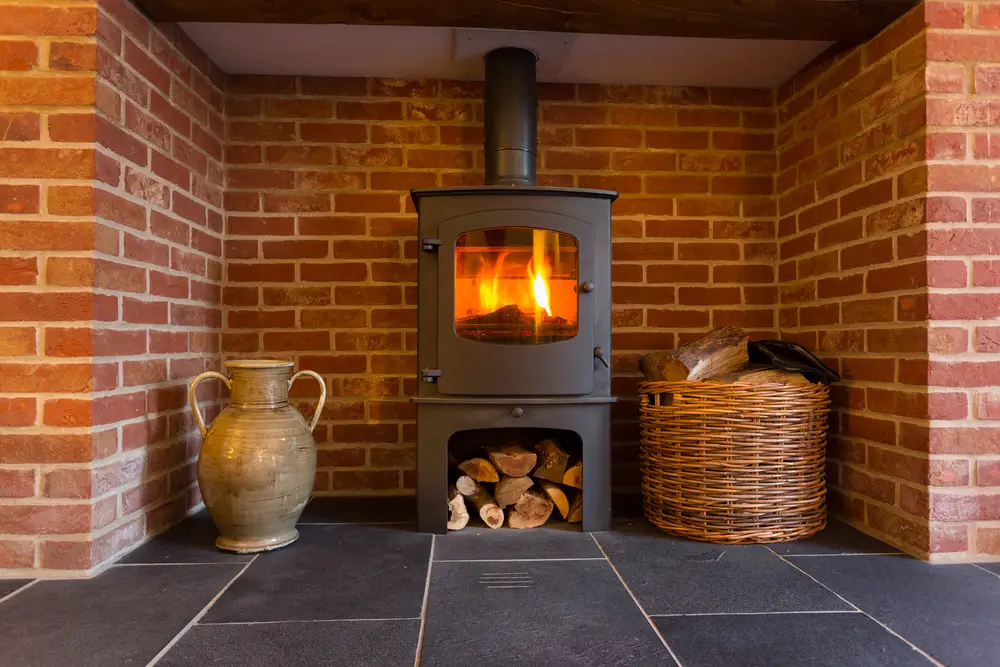Curious homeowners often wonder if it’s possible to have two fireplaces sharing the same chimney, and in this article, we’ll explore the feasibility and considerations of this intriguing idea.
A chimney takes up a considerable amount of space, so installing multiple chimneys in a home may not be convenient. Connecting multiple fireplaces and other appliances to one chimney sounds like a viable solution. But can you do that? What are the risks? Are there regulations for this practice?
Read on to find out more about whether it is possible to run multiple fireplaces on one chimney and get answers to your questions about the procedure.

How does a chimney work?
First, let’s clarify the difference between a chimney and a flue. While a chimney is the entire structure, a flue is a pipe or brick structure inside the chimney. It is the flue through which smoke passes. In a chimney, there may be multiple flues separated by bricks.
Hot air rises above cold air because the former is lighter than the latter. This is the principle on which a chimney operates. As the fire produces hot gasses, their movement creates a difference in air pressure between the room and the inside of the flue.
This pressure—known as draught—pushes air into the fire, causing it to keep burning. As the fire gets hotter, the air moves faster and therefore the chimney works smoothly. This movement occurs because the air outside the house is cooler than the air inside the house.
Fire does not burn properly when it does not suck in enough air, or in other words, when the system generates insufficient draught.
It is very important to keep each flue separate from another because leaks between the flues can cause fire hazards. How do you know if there are leaks?
Well, inspecting a flue requires some technical know-how and the use of a CCTV camera. But if you smell something coming from a fireplace in a different room, there might be a leak. If that is the case, ideally you should get the flue inspected before further use.
A more precise question is: how many appliances can share a flue? And the short answer is: every solid fuel-burning appliance should have its own flue.
According to the National Fire Protection Association, a solid fuel-burning appliance cannot share a chimney flue with another appliance using a different type of fuel.
This is because a wood-burning fireplace or appliance produces flammable creosote that can be ignited by the heat from a furnace exhaust. Some homeowners, however, defy this guideline and unknowingly put the safety of their homes at risk.
An appliance and a fireplace cannot share a flue. That means, you cannot have a furnace, water heater or boiler on the same flue used by a fireplace.
Neither can back-to-back fireplaces share a flue. Even if your fireplaces burn the same type of fuel, they cannot share a flue as long as they are installed on the same floor. For example, let’s say you are living in a one-storey house. There is one fireplace in your bedroom and another in your living room. These two fireplaces can share a chimney, but not a flue.
Multiple open coal fires can share the same chimney, and even the same flue. This setup is possible if two standards are met:
- The fireplaces burn the same fuel and are installed on different levels. For example, an open coal fire in your living room can share a flue with another open coal fire just above your living room. In such a case, a flue divider should be used.
- A double-sided fireplace, which has two open sides, can share the same chimney and flue. Such a fireplace is usually installed between two open spaces. While it offers double the warmth and requires double the space, it is indeed one single unit. So, it makes sense that a double-sided fireplace uses one flue.
You do not need a separate chimney for each fireplace. Fireplaces can share a chimney if they are vertically aligned, or share a wall. Unless your fireplaces are installed in the same area, they should not share a chimney.
But in general, there should be a separate flue for each fireplace. If multiple fireplaces share a chimney, combustion gasses may leak, leading to fire hazards.
You cannot use the same chimney for two wood-burning stoves—unless the chimney has two flues. As we have stated, there should be one flue for one solid fuel-burning appliance.
If you put multiple wood-burning stoves on a single flue, overdrafting will occur. Shared flues can also lead to fire and carbon monoxide hazards. And while a chimney flue can have two openings, you cannot vent a solid fuel-fired appliance into a gas-fired or oil-fired flue.
It is true that many homeowners have been venting multiple wood-burning stoves into one flue for decades without any issue. If the flue is wide enough, the issue of insufficient draught is quite unlikely.
However, because it is against the code, engaging in this practice is a bad idea. If you have a fire, you may be denied your homeowners insurance due to this illegal act.
Can you add a second fireplace to an existing chimney?
Yes, it’s a standard practice to add a second fireplace to an existing chimney. However, if one of them is a solid fuel burning fireplace, it must have its own flue. Your second fireplace can be a see-through, double-sided or multi-level fireplace.
An electric or gas fireplace does not need a flue or chimney. You need to install a separate flue inside your existing chimney only if you want to install a wood-burning fireplace.
Can I add a wood-burning stove to an existing chimney?
Unless the vent opening of your wood-burning stove is too narrow or too wide for the size of your existing chimney flue, you can directly add the stove to the chimney. However, fitting a chimney liner is a better way to do it.
In order to vent the wood stove through the existing chimney, it is a good practice to place the stove somewhere close to the current fireplace. A specially designed pipe is attached to the stove, and smoke is channeled through the pipe. You may not want to take it as a DIY project. Consider getting the help of a professional.

Conclusion
It is perfectly okay to vent multiple fireplaces to one chimney. But as we have explained, each appliance may or may not have its own flue. Several factors have to be taken into consideration when making a decision.
If you want to connect a wood stove to a fireplace flue, you must block the fireplace first. And the size of your woodstove’s liner must also be appropriate. You can insert a smaller liner only if the chimney is free of combustible materials.
Venting multiple oil gas boilers or furnaces into one flue is safe as long as you follow the guidelines. The appliances must be on the same floor, and the connectors must be offset, meaning they have to be hooked to the flue at different heights. If one of the connectors is smaller than the other, the smaller one should be positioned above the larger one.
It all comes down to maintaining the safety of your home while using fireplaces and appliances that make life easy and comfortable. Consider contacting a chimney expert if you think you need to get your chimney assessed. We hope now you are better prepared to make a decision.
References:
- https://energyeducation.ca/encyclopedia/Chimney#:~:text=Chimneys%20operate%20based%20on%20the,gases%20out%20of%20the%20building.
- https://www.actionchimneys.ie/how-chimney-works#:~:text=Chimneys%20operate%20on%20the%20principle,it%20rushes%20past%20the%20fire.
- https://www.nfpa.org/codes-and-standards/all-codes-and-standards/list-of-codes-and-standards/detail?code=211
- https://assets.publishing.service.gov.uk/government/uploads/system/uploads/attachment_data/file/1108428/ADJ_2022.pdf
- https://homeyhearth.com/multiple-fireplaces-connected-to-one-chimney/
- https://fivewaysfires.co.uk/blog/two-gas-fireplaces-same-chimney
- https://www.precisioncraft.com/log-homes-blog/fireplaces-sharing-chimney/#:~:text=Fireplaces%20on%20multiple%20levels%20can,will%20not%20block%20each%20other.
